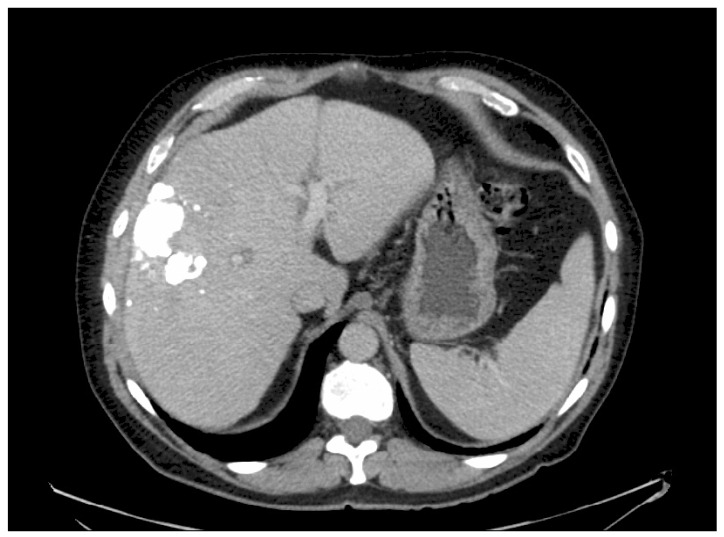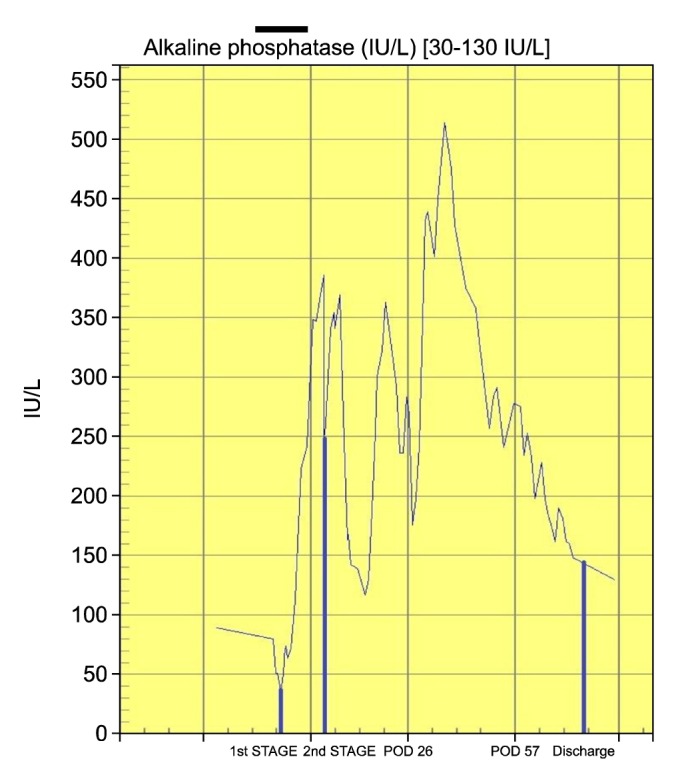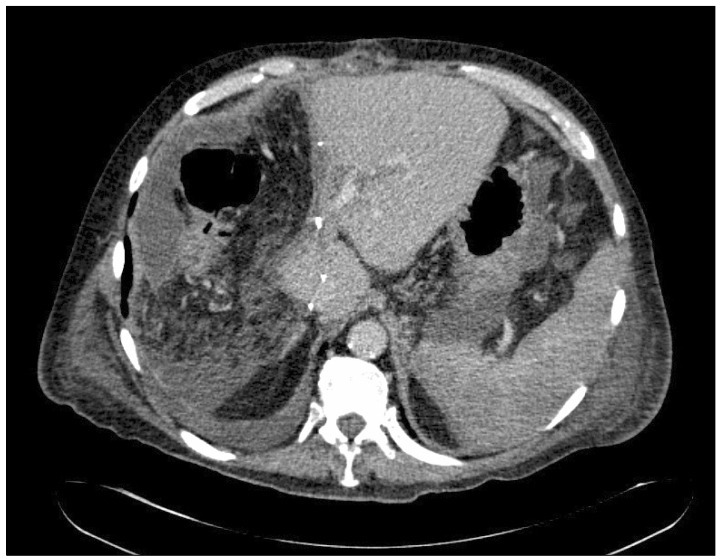Abstract
The incidence of complications after liver resection is closely related to functional future liver remnant (FLR). The standard approach to augment FLR is surgical or radiological occlusion of the artery or portal vein on the tumor side. Associated liver partition and portal vein ligation for staged hepatectomy (ALLPS) has been introduced as an alternative method to augment FLR. It offers rapid and effective hypertrophy for resecting liver metastases. However, data regarding its application in patients with hepatocellular carcinoma (HCC) with a background of chronic liver disease are limited. Here we describe the use of ALPPS procedure to manage a large solitary HCC with a background of chronic liver disease. The rising incidence of HCC has increased the number of surgical resections in patients with advanced stage liver disease not considered for liver transplantation. We reviewed reported experience of ALPPS in established chronic liver disease and current therapeutic modalities for HCC on a background of chronic liver disease in patients with potential liver insufficiency where tumor burden is beyond liver transplant criteria.
Despite advances in loco-regional therapies, surgical resection remains the gold standard treatment for managing primary and secondary liver tumors.1 The extent of liver resection is determined by tumor size and the position and function of future liver remnant (FLR) which in turn is related to liver quality, residual volume size, and the severity of underlying portal hypertension.
To avoid complications from hepatectomy, a variety of treatment modalities have been used to augment FLR prior to surgery, including transcatheter arterial chemoembolization (TACE) or embolization to devascularise tumors and reduce the extent of resection.1 Segmental atrophy of the segment to be resected and compensatory hypertrophy of future liver remnant can help lessen the impact of surgery. Portal vein embolization (PVE) in cirrhosis offers limited regenerative recovery compared to patients without liver disease.2 The resulting compensatory increase in arterial flow may facilitate tumor progression.234 Radiofrequency (RFA)/microwave ablation is limited to tumors <5 cm in size with ideal diameter of <4 cm. When tumor burden is beyond the accepted criteria for liver transplantation5 and when radiological intervention fails or is contraindicated, resection for hepatocellular carcinoma (HCC) represents the only curative treatment option.
Associated liver partition and portal vein ligation for staged hepatectomy (ALPPS) is a recent modification of the two-stage hepatectomy approach that allows for resecting liver tumors in two steps.6 In addition to ligating the portal vein inflow to the tumor-involved segments, ALPPS also disrupts the collateral communication between the two liver parts, thus allowing for more rapid hypertrophy of the remnant liver.67
Only a single case of ALPPS procedure for HCC on a background of liver cirrhosis has been reported in the literature.8 Here, we present a case of ALPPS for a large HCC on a background of chronic liver disease. In addition, we reviewed the literature of managing HCC with borderline FLR.
A 68 year-old man presented with intermittent right upper quadrant pain radiating to his right shoulder. His liver function tests showed serum bilirubin level at 17 µmol/L (3-20 µmol/L), aspartate aminotransferase (AST) level at 52 IU/L (normal range, 10-50 UI/L), gamma-glutamyl transpeptidase (γ-GT) level at 188 IU/L (normal range, 1-55 IU/L), albumin level of 44 g/L (normal range, 35-50 g/L), prothrombin time international normalized ratio (INR) of 1.15 (normal range, 0.8-1.6), and a model for end-stage liver disease (MELD) score of 14. Ultrasonography revealed a lesion within the right lobe of the liver with fibrotic changes in the parenchyma. His past medical history included diet-controlled diabetes mellitus and renal impairment secondary to hypertension. He had long-standing alcohol consumption at over 140 units per week. Viral hepatitis screen was negative.
Subsequent computed tomography (CT) imaging revealed an 8 cm mass in segments V/VIII with sectoral portal vein infiltration and washout on delayed venous phase with background of severe steatosis (Fig. 1). Radiological evidence of portal hypertension and splenomegaly was evident. No ascites was present. His CA 19-9 level was 40 U/ml (normal range, 0-37 U/ml), which was marginally elevated. He had normal α-fetoprotein level.
TACE with Doxorubicin (80 mg) and Lipiodol was performed with a good partial response. There was no liver decompensation. A non-lesional liver biopsy showed grade 2 siderosis and porto-septal fibrosis with porto-portal bridging. There was no evidence of parenchymal nodular, confirming severe steatosis and grade 3 bridging fibrosis. A second TACE was performed 3 months later. CT showed a partial response with tumor progression on the periphery (Fig. 2). Therefore, salvage hepatectomy was proposed.
The tumor occupied most of segments V and VIII with small satellite nodules in segment VII requiring extended right hepatectomy. Volumetric assessment revealed a FLR contributed to 14% of the total liver volume (1955 ml). Due to an inadequate FLR of segments I-IV, ALPPS procedure was proposed instead.
At the initial surgery, the right lobe was fully mobilized with the right portal vein ligated. The right hepatic artery, the right hepatic veins, and the middle hepatic veins were identified and preserved. Parenchymal transection was performed by using Cavitron ultrasonic surgical aspirator (CUSA), argon diathermy, and ligaclips. The dissection plane was placed between segment II/III and segment IV through the inferior vena cava. By the end of the procedure, the only connections between segment II/III and IV were bile duct, arterial inflow, and the right hepatic vein. The right liver was placed within a plastic bag at the end of the procedure to prevent tumor dissemination and minimize parenchymal contact between transection surfaces.
On day 1 postoperation, an arterial bleed from a branch of the right hepatic artery was embolized radiologically. Acute elevation of liver function tests immediately following surgery was gradually improved during the interim period (Figs. 3, 4, 5). CT scan at 10 days post-surgery showed that FLR was increased by 186 ml (274 ml vs. 460 ml; Fig. 6) with 68% volume gain after the 1st stage. Completion right hepatectomy was performed on day 14 without complication. Histology exams confirmed a large 130 mm-sized partially necrotic moderately differentiated HCC with multiple satellite nodules clear of the hepatic resection margin. The changes in the background liver were similar to those described in preoperative biopsy. Fibrosis was porto-septal with formation of slender and mainly porto-portal septa without parenchymal nodule formation (Figs. 7, 8).
Despite significant radiological increase in the volume of the remnant liver postoperatively (Fig. 9), the patient developed small-for-size syndrome. On day 5 postoperation, his serum bilirubin level was at 71 µmol/L with INR of 1.22. This resolved with conservative management. He was discharged from hospital after 12 weeks. At discharge, his serum bilirubin level, AST, and INR were 35 µmol/L, 24 UI/L, and 1.45, respectively. A follow-up CT scan at 6 months revealed a solitary recurrence in the remnant liver and bone metastases. The patient declined sorafenib treatment. He rapidly deteriorated and died 3 months later.
The ALPPS technique was first developed to manage patients with liver metastases with potentially small residual liver volume.6 This highlights its potential use for liver resection on background of chronic liver disease. The increase in FLR in our patient appeared to be comparable to that observed in patients without underlying liver disease.15
The principle for augmenting FLR is to restrict blood inflow to the side of tumor burden and to maximize blood flow to the FLR, leading to increased liver volume with time. This is normally achieved by portal venous occlusion using either radiological embolization (PVE) or surgical ligation that allows for compensatory hypertrophy to reduce the risk of small-for-size syndrome.910 However, the time period between portal vein occlusion and achieving an adequate remnant liver volume is unpredictable. It can take up to 6 weeks to achieve a satisfactory volume with the risk of progression of borderline tumor. However some surgeons advocate that a long interval to surgery identifies cases with aggressive biology who will not benefit from resection.671112
ALPPS was first described in 201211 as a way to expedite hypertrophy of future remnant liver from 4-6 weeks if using the "traditional" approach to 7-10 days.6712 The principal advantage of ALPPS is that it can reduce the interval for intervention with the aim to minimize the risk of disease progression. In addition, it allows for earlier assessment of the abdominal cavity and liver quality.913
The pathophysiological mechanism of ALPPS in enhancing the hypertrophic effect remains unclear. In addition to disrupting the main portal vein collaterals between the two lobes, ALPPS also divides venous collaterals within the liver parenchyma. The hypothesis is that by redistributing the total portal blood flow to the FLR, liver growth is more rapid.5
Liver regeneration in the context of chronic liver disease is less predictable.10 Although PVE may produce sufficient liver regeneration, it appears to be less effective than normal liver. In addition, the increased compensatory arterial flow can encourage tumor progression.141516 It has been suggested that sequential TACE and PVE should be used to achieve better tumor control and drive contralateral hypertrophy as the mean volume change in chronic liver disease appears to be higher.812151617 Published series of sequential TACE and PVE have achieved satisfactory FLR hypertrophy and allowed for safe major liver resections, suggest that sequential TACE and PVE is superior to PVE alone. In addition, tumor necrosis may facilitate resection and allow for additional parenchymal preservation.151617 PVE with TACE is not always feasible due to tumor extension or thrombotic complications within vascular structures.348
Our case demonstrated that increase in liver volume after ALPPS was rapid and appeared to be comparable to that of non-fibrotic liver or cirrhotic livers in which sequential TACE and PVE was used. However, this patient developed a degree of small-for-size syndrome, indicating that the functional status of the remnant liver did not increase to the same extent as the increase in remnant liver volume suggested. Therefore, volumetric assessment alone is not sufficient enough for assessing the functional capacity of FLR. Additional tests might be needed. Indocyanine green (ICG) clearance test has been used in the past as a predictor of hospital mortality after major liver resection. Interestingly, ICG clearance test before and after the first stage of ALPPS has not been assessed.181920 It may help predict FLR function.
Although ALPPS is being used to treat patients with liver diseases requiring major resection, it has a higher morbidity (35%) and mortality rate (16%) compared to conventional trisectionectomy with or without PVE.3414 A higher rate of morbidity should be expected regarding ALPPS. However, complications may reduce with increasing experience.
In the management of HCC on a background of chronic liver disease, data on the use of ALPPS to improve liver regeneration in comparison to radiological modalities such as TACE or PVE are currently very limited. Our case confirms that ALPPS is technically feasible to improve liver regeneration.21 Further experience of using ALPPS in the management of HCC and cirrhosis needs to be collected to understand whether this technique can offer potential advantages for HCC patients with chronic liver disease.
References
1. Ielpo B, Caruso R, Ferri V, Quijano Y, Duran H, Diaz E, et al. ALPPS procedure: our experience and state of the art. Hepatogastroenterology. 2013; 60:2069–2075. PMID: 24719949.
2. Aoki T, Imamura H, Hasegawa K, Matsukura A, Sano K, Sugawara Y, et al. Sequential preoperative arterial and portal venous embolizations in patients with hepatocellular carcinoma. Arch Surg. 2004; 139:766–774. PMID: 15249411.

3. Ogata S, Belghiti J, Farges O, Varma D, Sibert A, Vilgrain V. Sequential arterial and portal vein embolizations before right hepatectomy in patients with cirrhosis and hepatocellular carcinoma. Br J Surg. 2006; 93:1091–1098. PMID: 16779884.

4. Seo DD, Lee HC, Jang MK, Min HJ, Kim KM, Lim YS, et al. Preoperative portal vein embolization and surgical resection in patients with hepatocellular carcinoma and small future liver remnant volume: comparison with transarterial chemoembolization. Ann Surg Oncol. 2007; 14:3501–3509. PMID: 17899289.

5. De Carlis L, Belli LS, Romani F, Aseni P, Baticci F, Sansalone CV, et al. Selection criteria for liver transplantation: preliminary experience of Niguarda Hospital, Milan. Transplant Proc. 1989; 21:2415–2416. PMID: 2652788.
6. Alvarez FA, Ardiles V, Sanchez Claria R, Pekolj J, de Santibañes E. Associating liver partition and portal vein ligation for staged hepatectomy (ALPPS): tips and tricks. J Gastrointest Surg. 2013; 17:814–821. PMID: 23188224.

7. Tschuor Ch, Croome KP, Sergeant G, Cano V, Schadde E, Ardiles V, et al. Salvage parenchymal liver transection for patients with insufficient volume increase after portal vein occlusion -- an extension of the ALPPS approach. Eur J Surg Oncol. 2013; 39:1230–1235. PMID: 23994139.

8. Vennarecci G, Laurenzi A, Santoro R, Colasanti M, Lepiane P, Ettorre GM. The ALPPS procedure: a surgical option for hepatocellular carcinoma with major vascular invasion. World J Surg. 2014; 38:1498–1503. PMID: 24146197.

9. Schadde E, Ardiles V, Slankamenac K, Tschuor C, Sergeant G, Amacker N, et al. ALPPS offers a better chance of complete resection in patients with primarily unresectable liver tumors compared with conventional-staged hepatectomies: results of a multicenter analysis. World J Surg. 2014; 38:1510–1519. PMID: 24748319.

10. van Lienden KP, van den Esschert JW, de Graaf W, Bipat S, Lameris JS, van Gulik TM, et al. Portal vein embolization before liver resection: a systematic review. Cardiovasc Intervent Radiol. 2013; 36:25–34. PMID: 22806245.

11. Schnitzbauer AA, Lang SA, Goessmann H, Nadalin S, Baumgart J, Farkas SA, et al. Right portal vein ligation combined with in situ splitting induces rapid left lateral liver lobe hypertrophy enabling 2-staged extended right hepatic resection in small-for-size settings. Ann Surg. 2012; 255:405–414. PMID: 22330038.

12. Nadalin S, Capobianco I, Li J, Girotti P, Königsrainer I, Königsrainer A. Indications and limits for associating liver partition and portal vein ligation for staged hepatectomy (ALPPS). Lessons Learned from 15 cases at a single centre. Z Gastroenterol. 2014; 52:35–42. PMID: 24420797.

13. Shindoh J, Vauthey JN, Zimmitti G, Curley SA, Huang SY, Mahvash A, et al. Analysis of the efficacy of portal vein embolization for patients with extensive liver malignancy and very low future liver remnant volume, including a comparison with the associating liver partition with portal vein ligation for staged hepatectomy approach. J Am Coll Surg. 2013; 217:126–133. PMID: 23632095.

14. Zhang GQ, Zhang ZW, Lau WY, Chen XP. Associating liver partition and portal vein ligation for staged hepatectomy (ALPPS): a new strategy to increase resectability in liver surgery. Int J Surg. 2014; 12:437–441. PMID: 24704086.

15. Shindoh J, D Tzeng CW, Vauthey JN. Portal vein embolization for hepatocellular carcinoma. Liver Cancer. 2012; 1:159–167. PMID: 24159580.

16. Ribero D, Curley SA, Imamura H, Madoff DC, Nagorney DM, Ng KK, et al. Selection for resection of hepatocellular carcinoma and surgical strategy: indications for resection, evaluation of liver function, portal vein embolization, and resection. Ann Surg Oncol. 2008; 15:986–992. PMID: 18236112.

17. Vilgrain V, Sibert A, Zappa M, Belghiti J. Sequential arterial and portal vein embolization in patients with cirrhosis and hepatocellular carcinoma: the hospital beaujon experience. Semin Intervent Radiol. 2008; 25:155–161. PMID: 21326556.

18. Ng KK, Poon RT. Current treatment strategy for hepatocellular carcinoma. Saudi Med J. 2007; 28:1330–1338. PMID: 17768455.
19. Yokoyama Y, Nishio H, Ebata T, Igami T, Sugawara G, Nagino M. Value of indocyanine green clearance of the future liver remnant in predicting outcome after resection for biliary cancer. Br J Surg. 2010; 97:1260–1268. PMID: 20602507.

20. Cucchetti A, Cescon M, Trevisani F, Pinna AD. Current concepts in hepatic resection for hepatocellular carcinoma in cirrhotic patients. World J Gastroenterol. 2012; 18:6398–6408. PMID: 23197885.

21. Vennarecci G, Laurenzi A, Levi Sandri GB, Busi Rizzi E, Cristofaro M, Montalbano M, et al. The ALPPS procedure for hepatocellular carcinoma. Eur J Surg Oncol. 2014; 40:982–988. PMID: 24767805.

Fig. 1
Arterial phase CT imaging showing the presence of a lesion lying within the right liver segments V/VIII. It measures up to 8 cm showing enhancement, suggesting hepatocellular carcinoma.

Fig. 2
CT imaging of lesion post-TACE showing partial response of tumor with small future liver remnant.

Fig. 6
Post-1st stage ALPPS CT imaging showing significant increase in the volume of the future remnant liver.

Fig. 7
The tumor consisted of a moderately differentiated hepatocellular carcinoma with acinar pattern in this field (H&E, ×200).





 PDF
PDF ePub
ePub Citation
Citation Print
Print







 XML Download
XML Download